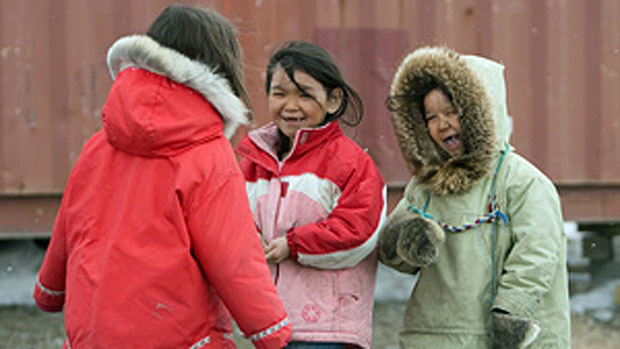Canadian population creeps up in average age
Median age of Canadians close to cracking 40, agency says
CBC News
Posted: Sep 28, 2011 12:55 PM ET
Last Updated: Sep 28, 2011 5:11 PM ET
 Children play together in Rankin Inlet, Nunavut, where the median age of 25,8 is the lowest in Canada, according to a Statistics Canada report released Wednesday. (Sean Kilpatrick/Canadian Press)
Children play together in Rankin Inlet, Nunavut, where the median age of 25,8 is the lowest in Canada, according to a Statistics Canada report released Wednesday. (Sean Kilpatrick/Canadian Press)
Related
External Links
(Note:CBC does not endorse and is not responsible for the content of external links.)
Western Canada and Prince Edward Island grew faster than other parts of the country last year, when population is the measure, but overall, Canada’s pace of growth slowed, Statistics Canada says.
At the same time, according to a population report released Wednesday:
- The country's median age edged closer to 40.
- A greater percentage of the population fell within the over-65 category.
- The under-15 category shrank.
An estimated 34,482,800 people lived in Canada as of July 1 — an increase of 356,600, or one per cent, over the year before, Statistics Canada said. The percentage gain the preceding year was slightly higher, at 1.2 per cent.
Seniors now make up 14.4 per cent of the population — an increase of 0.3 percentage points from the year before, the report said.
'The proportion of seniors will grow more rapidly in the coming years as the first generation of baby boomers are now reaching the age of 65.'— Statistics Canada population report
"The proportion of seniors will grow more rapidly in the coming years as the first generation of baby boomers are now reaching the age of 65," the agency said.
Different parts of the country showed different increases in population growth, with Prince Edward Island, at 1.7 per cent, and Alberta, at 1.6 per cent, topping the list.
Nunavut the most youthful
Canada's median age rose to 39.9 from 39.7, but across the country, there was quite a range — from under 25 years in Nunavut to almost 44 in Newfoundland.
Here is the breakdown of the median age across the country:
- Newfoundland and Labrador: 43.8
- Nova Scotia: 43.1
- New Brunswick: 43.0
- P.E. I.: 42.2
- Quebec: 41.4
- Ontario: 39.6
- Manitoba: 37.6
- Saskatchewan: 37.3
- Alberta: 36
- British Columbia: 41.1
- Yukon: 39.2
- Northwest Territories: 31.8
- Nunavut: 24.8
Share Tools
Top News Headlines
- Tori Stafford jury to hear from judge before deliberations

- WARNING: This story contains disturbing details. The judge will give his final instructions to the jury today before they begin their deliberations in the trial of Michael Rafferty, accused of raping and killing eight-year-old Victoria (Tori) Stafford.
 more »
more »
- Obama's backing of same-sex marriage gets mixed reviews

- President Barack Obama's surprise backing of same-sex marriage gets mixed reviews around the world, but appears to be doing him no harm in this U.S. election year. more »
- Syria says blasts in Damascus kill at least 50

- Two explosions have rocked the Syrian capital, leaving dozens of people dead and crippling an intelligence building, the CBC's Laura Lynch reported from site of the blasts. more »
- B.C. Mountie sues force for harassment

- CBC News has learned the high-profile Mountie who first spoke out against sexual harassment in the national police force is suing her employer, alleging years of 'persistent and ongoing' sexual harassment and bullying. more »
- Bodies recovered from Russian jet crash
- Rescuers have discovered bodies near the shattered wreckage of a new Russian-made passenger plane that smashed into the steep side of an Indonesian volcano during a flight to impress potential buyers. All 45 people on board are feared dead. more »
Latest Canada News Headlines
- NDP gains support in Tory areas, poll suggests
- A new poll suggests the New Democrats are widening their support across the country. more »
- B.C. Mountie sues force for harassment

- CBC News has learned the high-profile Mountie who first spoke out against sexual harassment in the national police force is suing her employer, alleging years of 'persistent and ongoing' sexual harassment and bullying. more »
- New pardon rules thwart student's rehabilitation
- A Nova Scotia man says the federal government's "tough on crime" law is making it impossible for him to restart his life. more »
- Fate of Canadian satellite project unclear

- Industry Minister Christian Paradis says Canada is committed to a project that would see the construction of new satellites, but the company contracted to design the Radarsat Constellation says it will soon be too late to revive the project. more »
The National
The Current
- Green Evangelists May. 9, 2012 9:20 PM A growing evangelical movement in the U.S. suggests the Bible encourages protecting the earth and believes environmentalism is a Christian virtue.
- Russian jet wreckage found in Indonesia
- MacKay apologizes over Russell Williams photo in booklet
- B.C. Mountie sues force for harassment
- Obama says same-sex marriage should be legal
- Anti-abortion activists tell Harper 'debate is on'
- Hélène Campbell back in hospital after lung transplant
- New pardon rules thwart student's rehabilitation
- Super-Earth's light seen for the first time
- B.C. teachers contract dispute heats up
















